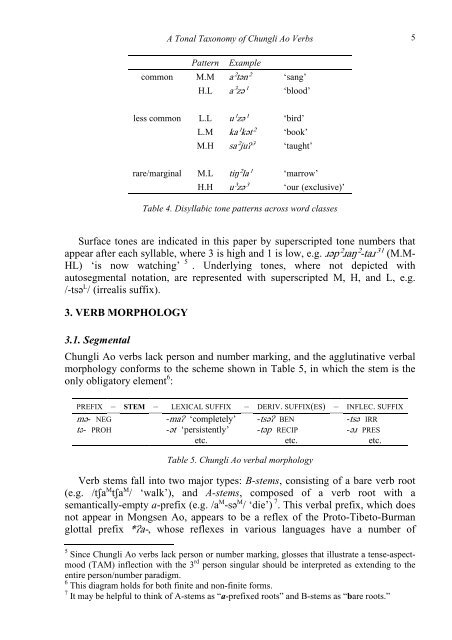A TONAL TAXONOMY OF CHUNGLI AO VERBS Daniel Bruhn ...
A TONAL TAXONOMY OF CHUNGLI AO VERBS Daniel Bruhn ...
A TONAL TAXONOMY OF CHUNGLI AO VERBS Daniel Bruhn ...
You also want an ePaper? Increase the reach of your titles
YUMPU automatically turns print PDFs into web optimized ePapers that Google loves.
A Tonal Taxonomy of Chungli Ao Verbs<br />
Pattern Example<br />
common M.M a²tən² ‘sang’<br />
H.L a³zə¹ ‘blood’<br />
less common L.L u¹zə¹ ‘bird’<br />
L.M ka¹kət² ‘book’<br />
M.H sa²juʔ³ ‘taught’<br />
rare/marginal M.L tiŋ²la¹ ‘marrow’<br />
H.H u³zə³ ‘our (exclusive)’<br />
Table 4. Disyllabic tone patterns across word classes<br />
Surface tones are indicated in this paper by superscripted tone numbers that<br />
appear after each syllable, where 3 is high and 1 is low, e.g. ɹəp²ɹaŋ²-taɹ³¹ (M.M-<br />
HL) ‘is now watching’ 5 . Underlying tones, where not depicted with<br />
autosegmental notation, are represented with superscripted M, H, and L, e.g.<br />
/-tsə L / (irrealis suffix).<br />
3. VERB MORPHOLOGY<br />
3.1. Segmental<br />
Chungli Ao verbs lack person and number marking, and the agglutinative verbal<br />
morphology conforms to the scheme shown in Table 5, in which the stem is the<br />
only obligatory element 6 :<br />
PREFIX – STEM – LEXICAL SUFFIX – DERIV. SUFFIX(ES) – INFLEC. SUFFIX<br />
mə- NEG -maʔ ‘completely’ -tsəʔ BEN -tsə IRR<br />
tə- PROH -ət ‘persistently’ -təp RECIP -əɹ PRES<br />
etc. etc. etc.<br />
Table 5. Chungli Ao verbal morphology<br />
Verb stems fall into two major types: B-stems, consisting of a bare verb root<br />
(e.g. /tʃa M tʃa M / ‘walk’), and A-stems, composed of a verb root with a<br />
semantically-empty a-prefix (e.g. /a M -sə M / ‘die’) 7 . This verbal prefix, which does<br />
not appear in Mongsen Ao, appears to be a reflex of the Proto-Tibeto-Burman<br />
glottal prefix *ʔa-, whose reflexes in various languages have a number of<br />
5 Since Chungli Ao verbs lack person or number marking, glosses that illustrate a tense-aspectmood<br />
(TAM) inflection with the 3 rd person singular should be interpreted as extending to the<br />
entire person/number paradigm.<br />
6 This diagram holds for both finite and non-finite forms.<br />
7 It may be helpful to think of A-stems as “a-prefixed roots” and B-stems as “bare roots.”<br />
5

















